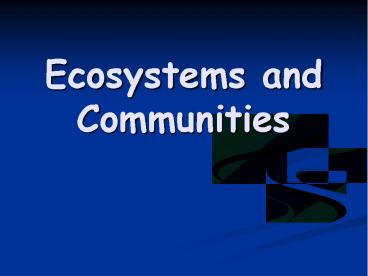Ecosystems and Communities PowerPoint PPT Presentation
Title: Ecosystems and Communities
1
Ecosystems and Communities
2
What is Climate?
4-1
- Weather is the day-to-day condition of Earths
atmosphere at a particular time and place - Climate refers to the average, year-after-year
conditions of temperature and precipitation in a
particular region.
3
The Greenhouse Effect
- What is it?
- A natural situation in which heat is retained by
a layer of greenhouse gases.
- What causes it?
- Carbon dioxide, methane, water vapor, and a few
other atmospheric gases trap heat energy and
maintain Earths temperature range.
4
(No Transcript)
5
Effects of Latitude on Climate
- Because earth is a sphere that is tilted, solar
radiation hits Earth at different angles - This creates 3 main climate zones
- Polar zones cold zones at the poles
- Tropical zones warm zones around the equator
- Temperate zones in between the polar and
tropical zones, vary from hot to cold throughout
the year
6
(No Transcript)
7
Heat Transport in the Biosphere
- The unequal heating of earths surface drives
winds and ocean currents spreading heat - Warm air at the equator rises, cool air at the
poles sinks creating wind currents - Warm water at the equator rises, cool water at
the poles sinks creating ocean currents
8
What Shapes an Ecosystem?
4-2
- Biotic and Abiotic Factors
- Niche
- Community Interactions
- Ecological Succession
9
Biotic Factors
- Ecosystems are influenced by a combination of
biological and physical factors. - Biotic Factors are the biological (living)
influences on organisms within an ecosystem. - Examples all living things it might interact
with, birds, trees, mushrooms, bacteria
10
Abiotic Factors
- Abiotic Factors are the physical (nonliving)
factors that shape ecosystems - Examples temperature, precipitation, humidity,
wind, nutrient availability, soil type, sunlight. - Together, biotic and abiotic factors determine
the survival and growth of an organism and the
productivity of the ecosystem in which the
organism lives.
11
The Niche
- A niche is the full range of physical and
biological conditions in which an organism lives
and the way in which the organism uses those
conditions. - A niche includes the type of food it eats, how it
obtains it, and which other species use the
organism as food. It also includes the physical
conditions it requires to survive and it includes
when and how it reproduces. - Everything an organism does to survive!
12
The Niche
- No two species can share the same niche in the
same habitat. - Different species can occupy niches that are very
similar
- Example
- Three species of North American warblers live in
the same spruce trees, but they feed at different
elevations and on different parts of the trees.
13
Community Interactions
- Community interactions, such as competition,
predation, and various forms of symbiosis, can
powerfully affect an ecosystem.
14
Competition
- Competition occurs when organisms of the same or
different species attempt to use an ecological
resource in the same place at the same time. - Resource refers to any necessity of life, such as
water, nutrients, light, food, or space. - The competitive exclusion principle, states that
no two species can occupy the same niche in the
same habitat at the same time.
15
Predation
- Predation is an interaction in which one organism
captures and feeds on another organism. - The predator is the organism that does the
killing. - The prey is the food organism, the organism that
is being hunted/eaten.
16
Predation
17
Symbiosis
- Symbiosis is any relationship in which two
species live closely together. - Symbiosis means living together
- Three main classes of symbiosis
- Mutualism
- Commensalisms
- Parasitism
18
Mutualism
- Mutualism is when both species benefit, they help
each other. - Example many flowers depend on certain species
of insects to pollinate them. - The flowers provide the insects with food (nectar
or pollen) and the insects help the flowers
reproduce.
19
Mutualism
20
Commensalisms
- Commensalism is when one member of the
association benefits and the other is neither
helped nor harmed. - Example barnacles attach themselves to a whales
skin. - The barnacles dont help or hurt the whale, but
the barnacles benefit because as the whale swims,
the constantly moving water carries the food the
barnacles eat to them.
21
Commensalisms
22
Parasitism
- Parasitism is when one organism lives on or
inside another organism and harms it. - The parasite obtains all or part of its
nutritional needs from the other organism, called
the host - Example tape worms live in the intestine of
mammals, Fleas, ticks , and lice live on the
bodies of mammals, feeding on the blood and skin
of the host
23
Parasitism
24
Ecological Succession
- Ecosystems are constantly changing in response to
natural and human disturbances. - As an ecosystem changes, older inhabitants
gradually die out and new organisms move in,
causing further changes in the community. - These predictable changes that occurs in a
community over time is called Ecological
Succession.
25
Ecological Succession
- Succession that occurs where no soil exists is
called primary succession. - When a disturbance of some kind changes an
existing community without removing the soil,
then secondary succession can take place.
26
Primary SuccessionStages
- The first species to populate the area are called
pioneer species. It is usually lichens. - Lichens break down rock, as they die they add
organic material to help form soil in which
plants can grow. - After lichens, mosses appear, and grasses take
root, then seedlings and shrubs can start to
sprout.
27
Lichens and Mosses (pioneer species)
28
Succession
29
Secondary Succession
- Secondary succession happens when land is
cleared and plowed for farming and is abandoned
or when wildfire burns woodlands.

